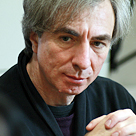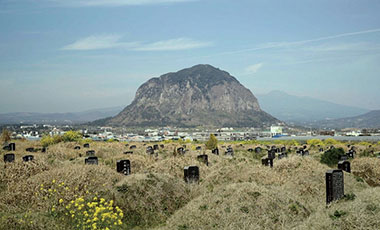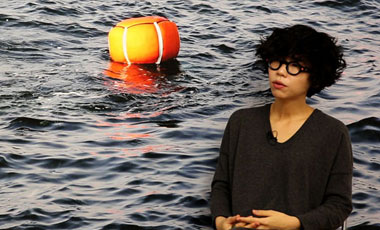Alessio Cavallaro Independent Curator, Director of ReelDance IncThe role of the curator in planning an exhibition involves building a bridge for artwork and viewer to share a meaningful, integrative experience... A lot of museums these days are planning exhibitions that combine with aspects of popular culture, but I think the important job of the curator/exhibition producer is to look at more experimental and innovative possibilities and present them to the public. With popular art forms, it's always possible to use media like television, radio, film. But it's difficult for anyone outside an art museum to survey the pioneering art of a particular age.
-

- Alessio Cavallaro/ Independent Curator, Director of ReelDance Inc Alessio Cavallaro was born in Italy, lives and works in Sydney, Australia, as an independent artistic director, curator and producer of innovative media arts. Most recently, as Director of ReelDance, he curated Dance on Screen 2012. From 2000?2010, Alessio was Senior Curator at the Australian Centre for the Moving Image (ACMI) in Melbourne, where he produced and curated more than 20 major exhibitions, most notably Transfigure (2003), SenseSurround (2004), Contemporary Commonwealth (2006), Len Lye (co-curated with Tyler Cann, 2009), and Bill Viola’s The Raft and The Tristan Project (2010), presented in association with Kaldor Public Art Projects. He curated the first group exhibition of Australian media art at Ars Electronica, Linz (2004), a screening program for the Australian Pavilion at World Expo 2010 Shanghai, and several sound art exhibitions, including MERIDIAN, Kobe, Japan (1993). A co-producer/curator of the influential event ISEA 1992 Sydney, Alessio is a member of the Curatorial Committee for ISEA 2013 Sydney, and is developing various projects across the fields of visual and performing arts, science and technology.
There is no bad art, only bad curators


Soo-youn LEE (L) : What are your impressions after participating in the Curating in Asia 2012 program?

![[Curating in Asia 2012] Cavallaro explains his project at a workshop.](/eng/people/20130215/3.jpg)
L : What exhibition of yours do you see as the most important and memorable?
A : Ever since I was young, I've been much more interested in experimental and avant garde music and art than in popular culture. In that sense, the most effective and influential exhibition for me would have to be Transfigure, which was my first planning effort the year after ACMI opened in 2003. It had to do with the body's perceptions - sight, hearing, and so forth - together with technology and phenomenology, and it also captured something of the identity of the newly opened ACMI. The idea was that this was an institution that studied moving images of every kind, and the exhibition included works of every type, heralding the arrival of a new visual culture: 16 mm film, music videos, biomedical visual equipment, interactive computer animation. It also had innovative artists like Char Davies who are pushing the boundaries of video and film with their perceptual experiments. [Editor's Note: Char Davies is a former painter who developed the 3D software company Softimage in the 1980s out of an interest in digital images. Since the 1990s, she has been a pioneer in virtual reality, exploring nature and the essence of existence. Her 1995 exhibition contribution Osmos is a virtual reality program that uses 3D graphics and sound to interact with the viewer, who gains an awareness of him- or herself within three-dimensional space through interacting with the virtual environment and sounds. Many have viewed this as a pioneering achievement in digital art.] Fittingly for an exhibition that actively incorporates and applies new technology, its collection remains available today as the website TRANSFIGURE, which received a Museums Australia Publications Design Award in 2004.
L : People often talk about exhibitions or projects being "experimental and innovative." How do exhibitions and work like this connect with audiences?
A : The role of the curator in planning an exhibition involves building a bridge for artwork and viewer to share a meaningful, integrative experience. No exhibition can make every viewer have the same exact experience with every work. There are just individual experiences, informed by our own thoughts and sensibilities. Even the most experimental work reflects the time and place it emerged from, so that as the viewers see it, they reflect on their own experience, which affects each of them in different way. For a media exhibition, the viewing environment is especially important in generating these emotions. You have to work to form an environment for serious appreciation of experimental and novel work within the exhibition space - like putting a black box in a white cube specifically for a media collection exhibition. [Editor's Note: In talking about media exhibition environments, Cavallaro mentioned Out of the Silent Planet, the National Museum of Contemporary Art, Korea's first media collection exhibition, for which the museum's gallery was modified into a black box, giving it the optimal light and sound quality for the media work to take on the aura of painting or sculpture for the viewer.] When I'm developing an exhibition, I tend to observe closely to see how the resonances of sound and light are perceived differently as the viewer moves around. As a result, I can relate experiences like seeing a solitary viewer in their 70s talking to Stelarc's Prosthetic Head (2002) for over an hour, or a little girl from Brussels becoming entranced by the new ecosystem of Jon McCormack's Eden (2000) and being unable to leave the gallery. [Editor's Note: Stelarc is an artist who uses the body for performance art. His Prosthetic Head is a 3D avatar of a head programmed with software to answer questions from its viewers. Even though it is only a program, viewers end up anthropomorphizing the software, somehow coming to expect something more as the head - with a face modeled on the artist -- makes gestures such as nodding or cocking to one side. Jon McCormack is a digital media artist with a strong interest in artificial life. Eden was inspired his experience with nature visiting Litchfield National Park in Australia; the natural system within its virtual space interacts with the viewer and responds to sounds and light from the surrounding environment. It is also self-generating and self-propagating, so that this fantastic natural system grows larger and larger as the exhibition continues.]
L : What is the most important job of the curator?
A : [Editor's Note: Cavallaro talked a lot about the curator's "job" and "role" during the three-day seminar. This is something he has given a lot of thought to over a career serving as senior curator at ACMI, director at ReelDance, and an independent curator. With the curators gathered together for the program, he hoped to continue sharing and discussing the role of curator as producer, collaborator, and even patron in contemporary culture.] A : A lot of museums these days are planning exhibitions that combine with aspects of popular culture, but I think the important job of the curator/exhibition producer is to look at more experimental and innovative possibilities and present them to the public. With popular art forms, it's always possible to use media like television, radio, film. But it's difficult for anyone outside an art museum to survey the pioneering art of a particular age. A good example was ACMI's retrospective in 2009 on Len Lye, an artist who made some of the most revolutionary achievements in film, painting, poetry, and sculpture in the early 1900s. National and public institutions that receive public funding need to be especially cognizant of this duty. [Editor's Note: In conversation, Cavallaro said that the curator needs to be able to usher an artist's experimentation and contemporariness into the public sphere, i.e., the exhibition space. He used the example of Vincent Van Gogh, saying that if there had been a publicly supported museum at the time he was working, a curator would have been able to reflect his discourse even if his work was not popular with the period's public. This, according to Cavallaro, is where the curator's expertise comes into play.] When ACMI was holding its Tim Burton exhibition, I said there had to be a section off to one side showing contemporary experimental art from Australia or Asia. I felt that having an experimental exhibition side-by-side with a popular exhibition would create an opportunity for more viewers to encounter modern art. I can't stress enough what an important role and job the curator has as someone who shapes the discourse of contemporary culture. Especially as modern art undergoes an increasing integration of the production, installation, and exhibition process, the ways in which contemporary art communicates with the public are often decided by the direction chosen by the curator. That's why I always stress the importance of the curator whenever I meet other curators. "There is no bad art, only bad curators."

Soo-youn LEE / Curator, National Museum of Contemporary Art, Korea
Curator, National Museum of Contemporary Art, Korea/ PhD candidate in the Art History Department at Seoul National University Soo-youn LEE was born in Seoul, Korea, in 1979. She studied linguistics at Seoul National University and received an M.A in art history; her master’s thesis was entitled, “Nam June Paik: Performance to Video Art, Expanding of Perceptions.” Her research interests include contemporary media art, screen studies, and performance. Since 2010 she has curated various exhibitions, including Out of the Silent Planet (2010), the first media collection show at the museum; Public Project Chonggye (2011); Art of Communication: Anri Sala, Yang Ah Ham, Philippe Parreno, Jorge Pardo (2011); and a performance exhibition with Hayward Gallery in London, Move (2012).


